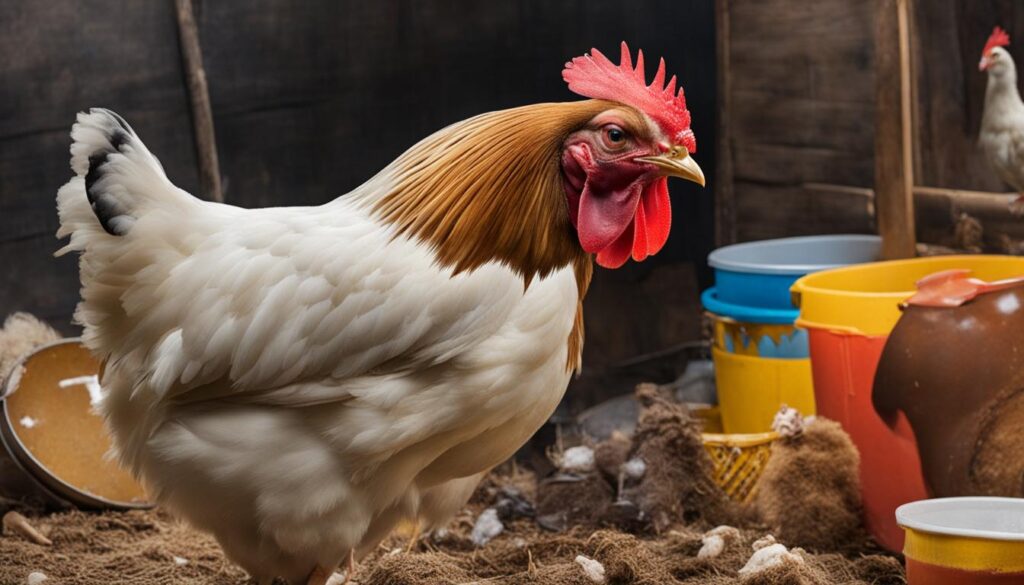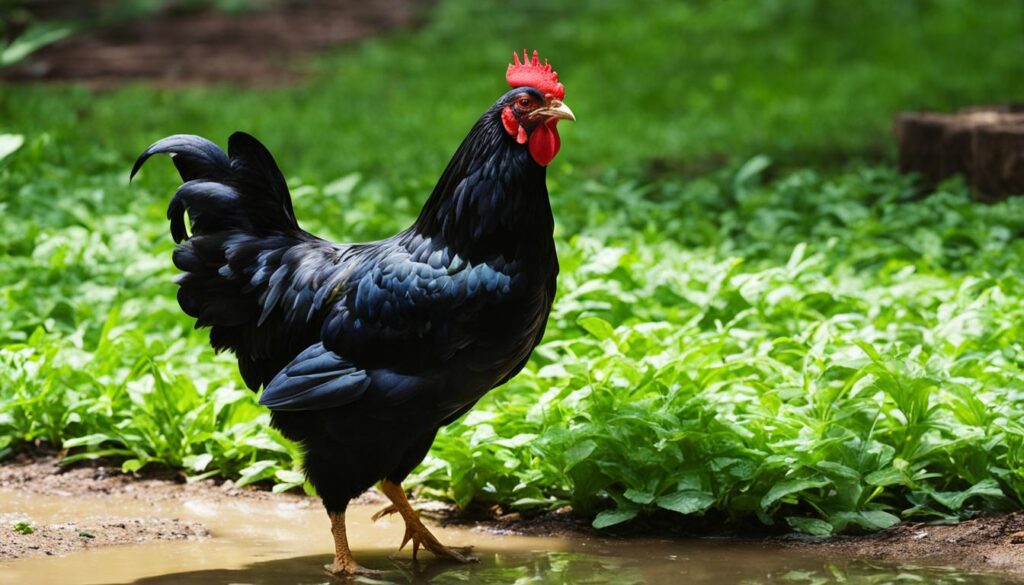As a seasoned backyard flock keeper, I’ve often been puzzled and concerned when spotting a chicken panting with its mouth open. Particularly, when the weather isn’t sweltering, and the question arises — why is my chicken panting with mouth open when it’s not hot? As it turns out, this scenario isn’t reserved for the dog days of summer. If you, too, are a hobby farmer and you’ve noticed your chicken has mouth open and is exhibiting unusual panting behavior, take heart. I’m here to share the insights gained from years tending to my own flock, to help you interpret and respond to this perplexing behavior.
Over time, I’ve discovered that a panting chicken with its mouth open signals several possible conditions, some benign and others requiring immediate attention. The key is not to panic but to approach the situation with a blend of concern, observation, and a readiness to act. Understanding the nuances of poultry behavior and health can be the difference between a small hiccup in your daily farm routine and a preventable issue. Let’s embark on this journey of discovery and proactive care together.
Key Takeaways
- Recognizing the difference between a chicken panting due to heat and other causes is crucial for poultry health.
- Even without heat, there are various reasons why a chicken has mouth open and is panting.
- Identifying the cause of panting is the first step toward ensuring your flock’s well-being.
- My firsthand experience equips you with insights to better care for your feathered friends.
- Creating a comfortable and secure environment for your chickens mitigates stress-induced behaviors.
- Proactive monitoring and rapid response to unusual panting can prevent larger health issues.
- Awareness and preparedness are key in managing a healthy, happy backyard flock.
Understanding Chicken Respiratory Behavior
As someone deeply invested in the health and well-being of backyard poultry, I find it crucial to understand the intricacies of chicken respiratory behavior. Recognizing the difference between a chicken’s normal respiratory activities and signs of potential distress is key to maintaining the flock’s overall health. It’s not just about observing your chickens; it’s about knowing what you’re looking for. Let’s dive into what constitutes normal breathing and what doesn’t.
Normal Breathing Vs. Panting in Chickens
In their natural state, chickens exhibit a rhythmic and relatively low-effort breathing pattern. It’s seamless and barely noticeable. However, when a chicken starts panting with its mouth open, it’s a clear signal that something is amiss. Panting is a mechanism chickens employ to cool down, much like dogs, since they don’t have sweat glands. It’s important to note, panting in moderation on a hot day is normal, but if it’s not hot and your chicken is still panting, pay attention—it might be more than just the weather.
Signs of Respiratory Distress in Poultry
Now let’s talk about the signs of respiratory distress in poultry, which every hobby farmer should be aware of. Respiratory issues can often present themselves in subtle ways before escalating to more severe symptoms. It’s these early signs that are critical to catch.
- Increased respiration rate or effort
- Audible wheezing or gasping for air
- Coughing, sneezing, or discharge from the nostrils
- Excessive head shaking or neck extension
- Facial swelling or discoloration
- Lethargy or reduced appetite, indicating discomfort
Observing these behaviors can give you a head start in addressing potential issues. Keeping a careful eye on your flock can make all the difference in ensuring their longevity and happiness. Below is a table that contrasts normal breathing with signs of respiratory distress to help you better understand what to look for.
| Normal Breathing | Signs of Respiratory Distress |
|---|---|
| Quiet, unlabored, even-paced | Loud, labored, irregular-paced |
| No visible effort | Obvious effort, neck stretching |
| No nasal discharge | Nasal discharge present |
| No change in comb or wattle color | Change in comb or wattle color, potentially blueish |
| Normal activity and appetite | Decreased activity and appetite |
Remember, each chicken is an individual, and what’s normal for one may not be for another. Regular observation of your flock’s behavior is vital in catching these contrasts early. By understanding the signs and knowing when to act, you can ensure your chickens maintain a clean bill of health.
Common Causes for Chicken Panting With Mouth Open Not Hot
As a seasoned hobby farmer, I’ve observed chickens displaying the unsettling behavior of panting with their mouths open, even when the cozy coop isn’t sweltering. If you’ve noticed your chicken mouth open but not hot, it’s crucial to decipher the reasons behind such patterns. Let me take you through some key causes of chicken panting that could provide valuable insights into your flock’s health and comfort.
Disentangling the reasons behind a chicken’s open-mouth panting, unrelated to heat, can reveal underlying issues that demand our immediate attention. It’s the subtler signs that often speak volumes about poultry health.
- Respiratory Infections: Just like us, chickens can suffer from respiratory issues. Illnesses such as chronic respiratory disease or infectious bronchitis can cause labored breathing and panting.
- Heart Health: Underlying cardiovascular problems can manifest as panting, signaling that it’s time for a health check from a veterinarian.
- Stress Factors: Environmental stressors like loud noises or the presence of predators can trigger stress panting.
- Overexertion: Chickens who have recently engaged in frenetic activity, such as running from perceived threats, may pant to recover.
Understanding the causes of chicken panting can guide us to provision better care and a more tranquil habitat for these feathered friends. A cooperative and observant approach is vital for promoting the health and welfare of your chickens.

Now that you’re more informed about the environmental and health-related factors contributing to your chicken’s panting habit, you’re better equipped to respond accordingly and ensure your coop remains a haven of comfort all year round.
Immediate Steps to Take When You Notice Unusual Panting
Encountering a chicken panting with its mouth open can be unsettling. As a dedicated hobby farmer, I know the importance of responding quickly to this sign of distress. Incidents of unusual panting call for quick-thinking and practical solutions to alleviate the immediate issue and prevent any potential harm to your flock’s health.
Assessing Your Chicken’s Environment
One of the first immediate steps for a panting chicken is assessing their environment. Often, environmental stressors can go unnoticed, and it’s our duty to identify and rectify them. For example, on hotter days, even when it doesn’t seem scorching to us, chickens may experience heat more intensely due to their feathered coats and physiological makeup.

Providing Relief and Cooling Strategies
After assessing the chicken environment, implementing relief and cooling strategies is paramount. Here are a few methods I’ve used with great success:
- Ensure that their coop is well-ventilated and remove any excess bedding that may trap heat.
- Provide access to fresh, cold water throughout the day; you might even add ice cubes to the waterers on extremely hot days.
- Create shaded areas using tarps or greenery where chickens can retreat from direct sunlight.
- Consider installing fans to promote airflow, but ensure that they’re secured and out of reach of curious beaks.
- Limit strenuous activities by offering food during cooler parts of the day, which discourages unnecessary exertion when it’s warm.
Adopting these cooling strategies quickly can provide significant relief to panting chickens, and in many cases, prevent escalation to more serious health issues. Be mindful of their behavior post-intervention; it should normalize as they cool down and find relief.
Long-Term Solutions for Preventing Heat Stress
As a devoted hobby farmer, I can’t emphasize enough the significance of devising long-term strategies to keep our feathered friends comfortable, especially when it comes to preventing chicken heat stress. Heat stress can be deceptive and not always immediately noticeable until it becomes a serious concern for your flock’s health and productivity. Therefore, I’ll share tactics that have proven effective in my own experience, focusing on creating a sustainable habitat that naturally mitigates the risk of overheating.
Coop Ventilation and Shade Set-Up
Coop ventilation is paramount in managing temperature and ensuring a fresh air supply. A well-ventilated coop helps in regulating the climate within and prevents the buildup of ammonia and moisture, which can contribute to respiratory issues. My coop features strategically placed vents and windows that allow for cross-breezes, crucial for maintaining a cooler environment during hotter months. Equally important is providing ample shade. I’ve planted deciduous trees around my coop — they offer shade in the summer and allow sunlight to warm the coop during winter when they shed their leaves.
Managing Flock Density and Access to Water
Additionally, flock density management is a critical aspect that some might overlook. Overcrowding can lead to excessive warmth and increased competition for resources, which can stress your chickens. I make certain there’s enough room for each bird to move freely, roost comfortably, and access feeding points without congestion. Lastly, access to water is non-negotiable. Chickens require a constant supply of clean water to remain hydrated and regulate their body temperature effectively. I use multiple water stations to avoid any disputes and ensure that every chicken gets its fair share, even on the hottest days.
